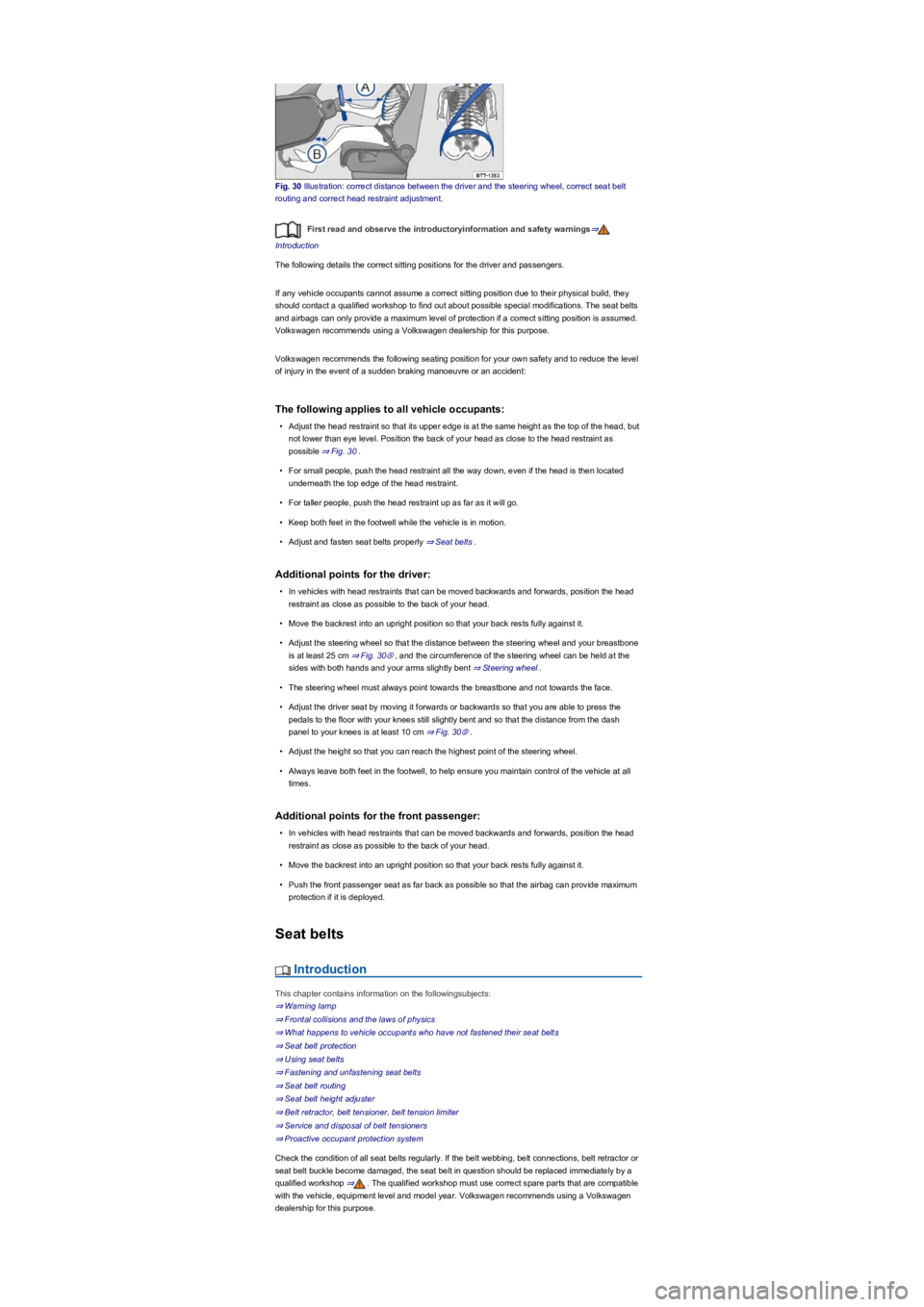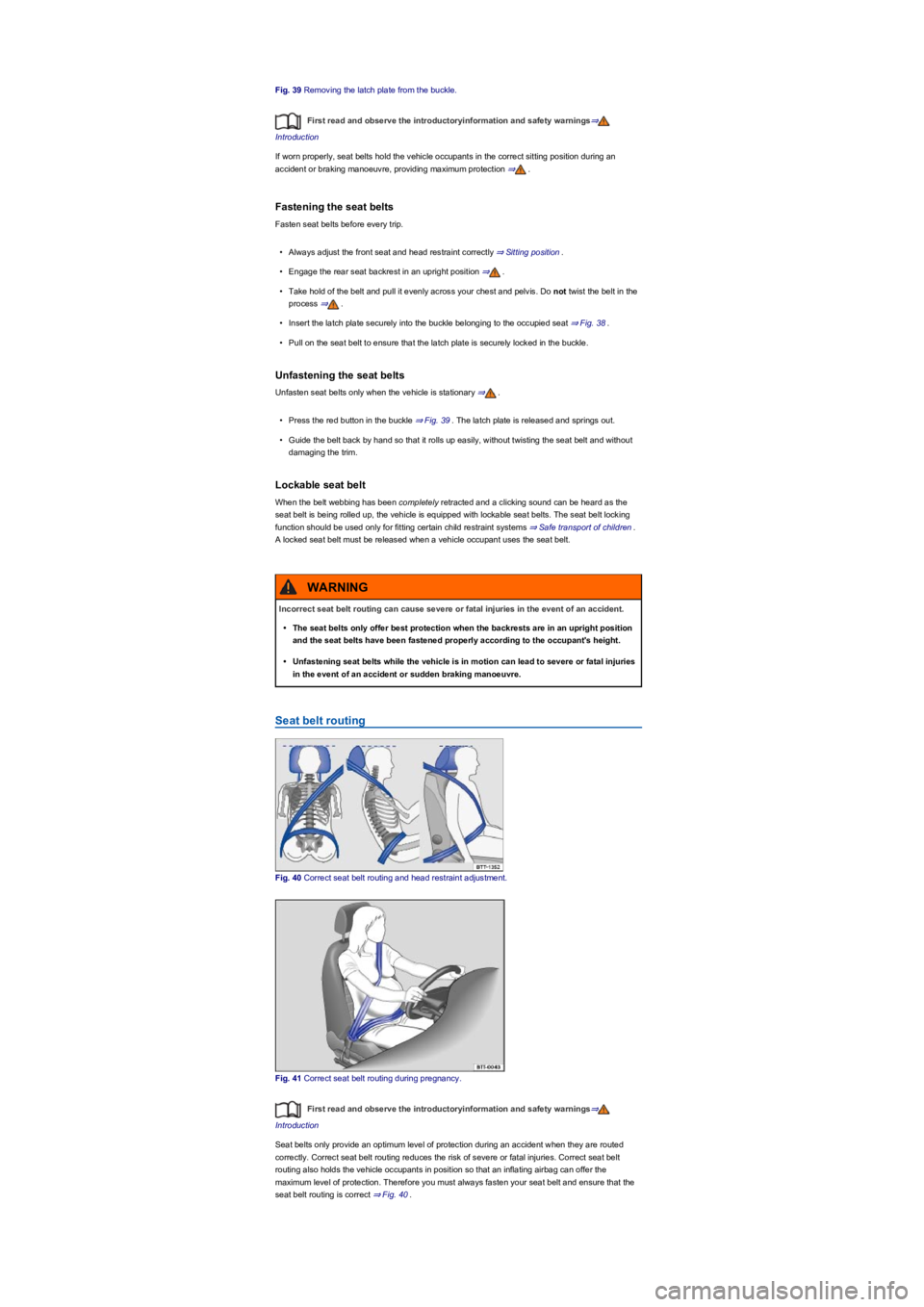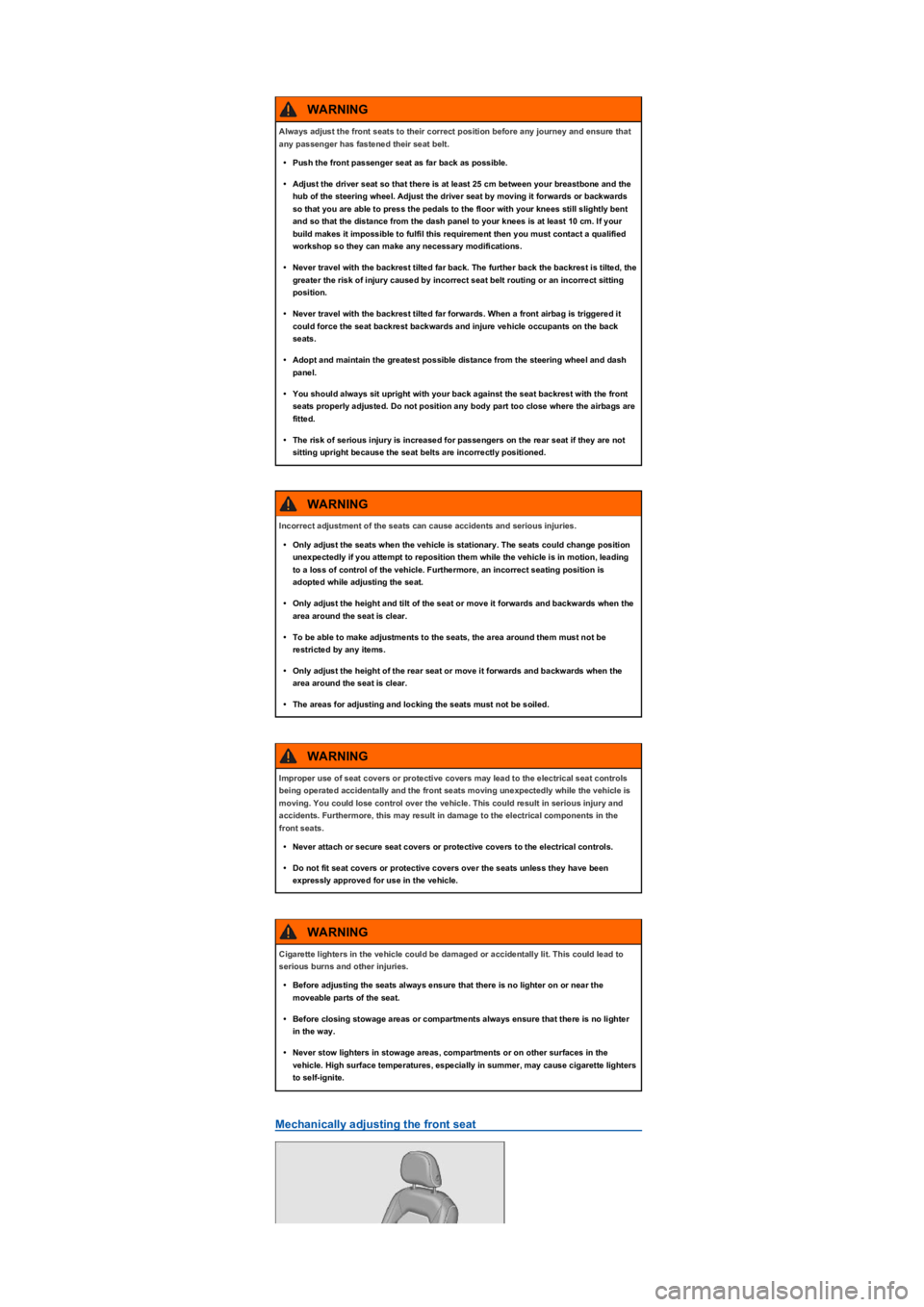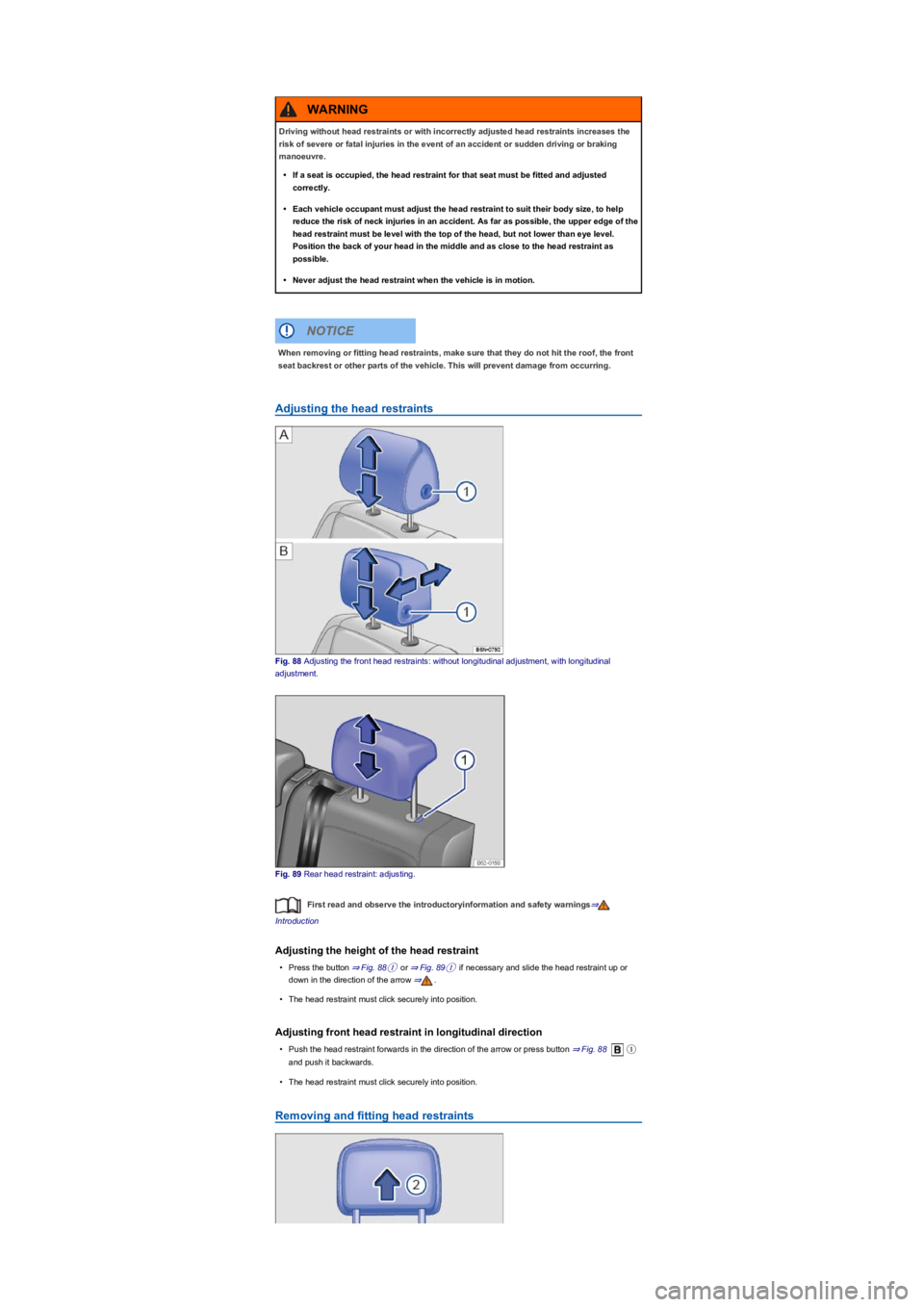2021 VOLKSWAGEN TIGUAN height adjustment
[x] Cancel search: height adjustmentPage 38 of 341

Fig. 30 Illustration: correct distance between the driver and the steering wheel, correct seat belt
routing and correct head restraint adjustment.
First read and observe the introductoryinformation and safety warnings⇒
Introduction
The following details the correct sitting positions for the driver and passengers.
If any vehicle occupants cannot assume a correct sitting position due to their physical build, they
should contact a qualified workshop to find out about possible special modifications. The seat belts
and airbags can only provide a maximum level of protection if a correct sitting position is assumed.
Volkswagen recommends using a Volkswagen dealership for this purpose.
Volkswagen recommends the following seating position for your own safety and to reduce the level
of injury in the event of a sudden braking manoeuvre or an accident:
The following applies to all vehicle occupants:
•Adjust the head restraint so that its upper edge is at the same height as the top of the head, but
not lower than eye level. Position the back of your head as close to the head restraint as
possible ⇒ Fig. 30.
•For small people, push the head restraint all the way down, even if the head is then located
underneath the top edge of the head restraint.
•For taller people, push the head restraint up as far as it will go.
•Keep both feet in the footwell while the vehicle is in motion.
•Adjust and fasten seat belts properly ⇒ Seat belts.
Additional points for the driver:
•In vehicles with head restraints that can be moved backwards and forwards, position the head
restraint as close as possible to the back of your head.
•Move the backrest into an upright position so that your back rests fully against it.
•Adjust the steering wheel so that the distance between the steering wheel and your breastbone
is at least 25 cm ⇒ Fig. 30Ⓐ, and the circumference of the steering wheel can be held at the
sides with both hands and your arms slightly bent ⇒ Steering wheel.
•The steering wheel must always point towards the breastbone and not towards the face.
•Adjust the driver seat by moving it forwards or backwards so that you are able to press the
pedals to the floor with your knees still slightly bent and so that the distance from the dash
panel to your knees is at least 10 cm ⇒ Fig. 30Ⓑ.
•Adjust the height so that you can reach the highest point of the steering wheel.
•Always leave both feet in the footwell, to help ensure you maintain control of the vehicle at all
times.
Additional points for the front passenger:
•In vehicles with head restraints that can be moved backwards and forwards, position the head
restraint as close as possible to the back of your head.
•Move the backrest into an upright position so that your back rests fully against it.
•Push the front passenger seat as far back as possible so that the airbag can provide maximum
protection if it is deployed.
Seat belts
Introduction
This chapter contains information on the followingsubjects:
⇒ Warning lamp
⇒ Frontal collisions and the laws of physics
⇒ What happens to vehicle occupants who have not fastened their seat belts
⇒ Seat belt protection
⇒ Using seat belts
⇒ Fastening and unfastening seat belts
⇒ Seat belt routing
⇒ Seat belt height adjuster
⇒ Belt retractor, belt tensioner, belt tension limiter
⇒ Service and disposal of belt tensioners
⇒ Proactive occupant protection system
Check the condition of all seat belts regularly. If the belt webbing, belt connections, belt retractor or
seat belt buckle become damaged, the seat belt in question should be replaced immediately by a
qualified workshop ⇒. The qualified workshop must use correct spare parts that are compatible
with the vehicle, equipment level and model year. Volkswagen recommends using a Volkswagen
dealership for this purpose.
Page 43 of 341

Fig. 39 Removing the latch plate from the buckle.
First read and observe the introductoryinformation and safety warnings⇒
Introduction
If worn properly, seat belts hold the vehicle occupants in the correct sitting position during an
accident or braking manoeuvre, providing maximum protection ⇒.
Fastening the seat belts
Fasten seat belts before every trip.
•Always adjust the front seat and head restraint correctly ⇒ Sitting position.
•Engage the rear seat backrest in an upright position ⇒.
•Take hold of the belt and pull it evenly across your chest and pelvis. Do not twist the belt in the
process ⇒.
•Insert the latch plate securely into the buckle belonging to the occupied seat ⇒ Fig. 38.
•Pull on the seat belt to ensure that the latch plate is securely locked in the buckle.
Unfastening the seat belts
Unfasten seat belts only when the vehicle is stationary ⇒.
•Press the red button in the buckle ⇒ Fig. 39. The latch plate is released and springs out.
•Guide the belt back by hand so that it rolls up easily, without twisting the seat belt and without
damaging the trim.
Lockable seat belt
When the belt webbing has been completely retracted and a clicking sound can be heard as the
seat belt is being rolled up, the vehicle is equipped with lockable seat belts. The seat belt locking
function should be used only for fitting certain child restraint systems ⇒ Safe transport of children.
A locked seat belt must be released when a vehicle occupant uses the seat belt.
Seat belt routing
Fig. 40 Correct seat belt routing and head restraint adjustment.
Fig. 41 Correct seat belt routing during pregnancy.
First read and observe the introductoryinformation and safety warnings⇒
Introduction
Seat belts only provide an optimum level of protection during an accident when they are routed
correctly. Correct seat belt routing reduces the risk of severe or fatal injuries. Correct seat belt
routing also holds the vehicle occupants in position so that an inflating airbag can offer the
maximum level of protection. Therefore you must always fasten your seat belt and ensure that the
seat belt routing is correct ⇒ Fig. 40.
Incorrect seat belt routing can cause severe or fatal injuries in the event of an accident.
•The seat belts only offer best protection when the backrests are in an upright position
and the seat belts have been fastened properly according to the occupant's height.
•Unfastening seat belts while the vehicle is in motion can lead to severe or fatal injuries
in the event of an accident or sudden braking manoeuvre.
WARNING
Page 89 of 341

Mechanically adjusting the front seat
Always adjust the front seats to their correct position before any journey and ensure that
any passenger has fastened their seat belt.
•Push the front passenger seat as far back as possible.
•Adjust the driver seat so that there is at least 25 cm between your breastbone and the
hub of the steering wheel. Adjust the driver seat by moving it forwards or backwards
so that you are able to press the pedals to the floor with your knees still slightly bent
and so that the distance from the dash panel to your knees is at least 10 cm. If your
build makes it impossible to fulfil this requirement then you must contact a qualified
workshop so they can make any necessary modifications.
•Never travel with the backrest tilted far back. The further back the backrest is tilted, the
greater the risk of injury caused by incorrect seat belt routing or an incorrect sitting
position.
•Never travel with the backrest tilted far forwards. When a front airbag is triggered it
could force the seat backrest backwards and injure vehicle occupants on the back
seats.
•Adopt and maintain the greatest possible distance from the steering wheel and dash
panel.
•You should always sit upright with your back against the seat backrest with the front
seats properly adjusted. Do not position any body part too close where the airbags are
fitted.
•The risk of serious injury is increased for passengers on the rear seat if they are not
sitting upright because the seat belts are incorrectly positioned.
WARNING
Incorrect adjustment of the seats can cause accidents and serious injuries.
•Only adjust the seats when the vehicle is stationary. The seats could change position
unexpectedly if you attempt to reposition them while the vehicle is in motion, leading
to a loss of control of the vehicle. Furthermore, an incorrect seating position is
adopted while adjusting the seat.
•Only adjust the height and tilt of the seat or move it forwards and backwards when the
area around the seat is clear.
•To be able to make adjustments to the seats, the area around them must not be
restricted by any items.
•Only adjust the height of the rear seat or move it forwards and backwards when the
area around the seat is clear.
•The areas for adjusting and locking the seats must not be soiled.
WARNING
Improper use of seat covers or protective covers may lead to the electrical seat controls
being operated accidentally and the front seats moving unexpectedly while the vehicle is
moving. You could lose control over the vehicle. This could result in serious injury and
accidents. Furthermore, this may result in damage to the electrical components in the
front seats.
•Never attach or secure seat covers or protective covers to the electrical controls.
•Do not fit seat covers or protective covers over the seats unless they have been
expressly approved for use in the vehicle.
WARNING
Cigarette lighters in the vehicle could be damaged or accidentally lit. This could lead to
serious burns and other injuries.
•Before adjusting the seats always ensure that there is no lighter on or near the
moveable parts of the seat.
•Before closing stowage areas or compartments always ensure that there is no lighter
in the way.
•Never stow lighters in stowage areas, compartments or on other surfaces in the
vehicle. High surface temperatures, especially in summer, may cause cigarette lighters
to self-ignite.
WARNING
Page 96 of 341

Adjusting the head restraints
Fig. 88 Adjusting the front head restraints: without longitudinal adjustment, with longitudinal
adjustment.
Fig. 89 Rear head restraint: adjusting.
First read and observe the introductoryinformation and safety warnings⇒
Introduction
Adjusting the height of the head restraint
•Press the button ⇒ Fig. 88① or ⇒ Fig. 89① if necessary and slide the head restraint up or
down in the direction of the arrow ⇒.
•The head restraint must click securely into position.
Adjusting front head restraint in longitudinal direction
•Push the head restraint forwards in the direction of the arrow or press button ⇒ Fig. 88①
and push it backwards.
•The head restraint must click securely into position.
Removing and fitting head restraints
Driving without head restraints or with incorrectly adjusted head restraints increases the
risk of severe or fatal injuries in the event of an accident or sudden driving or braking
manoeuvre.
•If a seat is occupied, the head restraint for that seat must be fitted and adjusted
correctly.
•Each vehicle occupant must adjust the head restraint to suit their body size, to help
reduce the risk of neck injuries in an accident. As far as possible, the upper edge of the
head restraint must be level with the top of the head, but not lower than eye level.
Position the back of your head in the middle and as close to the head restraint as
possible.
•Never adjust the head restraint when the vehicle is in motion.
WARNING
When removing or fitting head restraints, make sure that they do not hit the roof, the front
seat backrest or other parts of the vehicle. This will prevent damage from occurring.
NOTICE